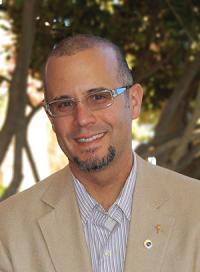Staying Connected
Spring
2014
Message from the President
Staying Connected
William DeGraffenreid, Professor of Physics, California State University in Sacramento, President, Sigma Pi Sigma
 As I approach the end of my 12th year as a faculty member at Sacramento State, I find myself with a relatively long mental list of students who have been through my classes, earned their degrees, and moved on to the next stages of their careers. It is always fun to get phone calls, e-mails, Facebook status updates, and even office visits from them. (While working on this letter, I was visited by a former student who now teaches at a local public high school.) One finds a remarkable diversity in what students do after graduating; some go to academia and to industry, while others take jobs in education or government or technical writing.
As I approach the end of my 12th year as a faculty member at Sacramento State, I find myself with a relatively long mental list of students who have been through my classes, earned their degrees, and moved on to the next stages of their careers. It is always fun to get phone calls, e-mails, Facebook status updates, and even office visits from them. (While working on this letter, I was visited by a former student who now teaches at a local public high school.) One finds a remarkable diversity in what students do after graduating; some go to academia and to industry, while others take jobs in education or government or technical writing.
Given the diversity of careers that physics majors pursue, one could wonder what it is that they all have in common. What is it that leads them to these wide-flung places? Perhaps our physics students are remarkable because they have learned how to solve complex problems; I personally believe that this training is the most valuable service we provide in colleges and universities. Every profession values the ability to look at a complex issue, understand the interrelated factors that contribute to its knottiness, apply thoughtful approaches, and then explain possible solutions.
Most students entering physics programs do so thinking that they will become research scientists or professors. (Blame could be placed on the television show The Big Bang Theory, but this mindset existed well before the show.) Though many will enter such professions, many will not. The American Institute of Physics Statistical Research Center reported in 2012 that only about 60 percent of bachelor’s degree recipients move into graduate school within a year of earning their degree, and many do so in fields other than physics. You can read the report, “Physics Bachelor’s One Year Later,” at http://goo.gl/2DZKt8.
As I see it, members of Sigma Pi Sigma who share their own experiences with today’s students provide outstanding opportunities both for their students, and for themselves. In this issue of Radiations, we are showcasing alumni connections. If you are an alumnus, by taking a little time out of your day to visit a physics department or SPS / Sigma Pi Sigma chapter, give a talk, and share a meal with students, you can open doors to career possibilities they have never considered. And you might find students who can contribute to your laboratory, company, or organization—as interns, research assistants, or lab technicians, to list a few examples. And you will certainly find that you will feel good sharing your story with the next generation of physicists and physics-minded professionals, whatever career paths they ultimately choose. If you are a student, reach out to those who have gone before—they have much to share.

